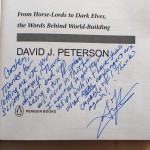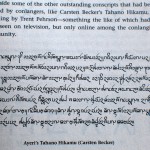- CLARIFICATION: David J. Peterson contacted me about providing an image featuring Ayeri’s script for his book in fall 2014, and it has subsequently appeared in the book (see the blog post of October 1, 2015, “You’ve Got Mail”). As a contributor, I received a signed specimen copy of the book after it had been launched in late September 2015 and decided myself to review it; all of the below is my own opinion. Even though I can’t be fully unbiased in my judgement anymore due to contributing to the book and receiving praise in it, I have still tried to be as fair as possible by highlighting both good and bad characteristics of the book in a constructive manner according to my own experience after over a decade in the community. I urge you to also read other reviews for a more balanced view.

From Horse Lords to Dark Elves to the language-affine TV watcher – David J. Peterson’s personal behind-the-scenes of language creation. A review.
Why is it that we make up languages, of all things? Why not write? Why not draw, paint or sculpt? Why not compose? For me at least, this recent tweet summarizes it nicely (although I also do photography):
I can’t draw well and I’m not confident in my writing, so creating #conlangs is my arts and crafts.
—Robbie Antenesse (@robbieantenesse), October 4, 2015
Making up languages is maybe not a mainstream hobby (and that’s not necessarily a bad thing in my humble opinion), but it’s still a valuable creative outlet for a good few people, and also for me. And for David J. Peterson, who gained his laurels in the community with his creating the Dothraki language for the wildly popular HBO series Game of Thrones, based on the novel series A Song of Ice and Fire by George R. R. Martin.
In his freshly published book, The Art of Language Invention: From Horse-Lords to Dark Elves, the Words behind World-Building (292 pages, Penguin 2015, ISBN 978-0-14-312646-1, $17), David J. Peterson explores how the Craft came into being, from the 12th century German nun Hildegard von Bingen to today’s sprawling online community, additionally drawing on a stockpile of anecdotes from the early days of the internet and his own experiences with creating languages both for fun and for money, which form the heart of the book. The meat, then, is a basic introduction to linguistics for those interested bystanders and fans who want to dip their toes into deeper waters.
A thing I really liked about Peterson’s book is that Peterson is very honest from the get-go: you will not find quick success if you seriously intend to make up a language or several and want to do it well. It takes time. It takes work. And it’s totally worth it getting engrossed in descriptions of the myriad of fascinating twists and turns that languages make to get meaning across. A sense of the joy of building up, destroying, improving, and also of solving puzzles can be deeply felt especially in the “Case Studies” after every main chapter of the book, in which Peterson discusses his own approaches to the respective topics while creating his languages. These are also the parts that contain background anecdotes about his work with TV producers and are probably the most entertaining parts of the whole book, for seasoned language tinkerers and people interested in some insider information on the TV shows’ production alike.
But even in the ‘meat’ chapters and in spite of linguistics being a rather academic topic with lots and lots of technical vocabulary, you will find Peterson’s original humor breaking through even the most dire technical discussions by referencing Harry Potter, Soundgarden, Michael Jackson, werewolves, cranky printers, and discussing the absolute and utter awfulness of onions among other things. Oh, and cats. This is 2015, after all, and we all love cats on the internet. Needless to say, since this is an introductory book, discussions of more complex aspects of language are simplified, though usually in a reasonable way that allows you to expand on later. There is only so much information you can put between the two covers of a 290-page book, anyway, and Peterson says so himself. For the $17 the book sets you back, you will get a whole lot of information, though.
Another aspect worth noting from a long-term hobbyist’s point of view is that Peterson never fails to make it clear that English is not the standard average language, but that it has its own peculiarities (apart from its infamously baroque spelling system) which everyone who is serious about creating languages needs to take into consideration lest he or she unwittingly rip off English. In a similar vein, Peterson frequently encourages his readers to do their own research into languages both natural and artistic in order to broaden their understanding and to develop a feeling for what is natural and possible. After all, a master needs to know his or her tools, and for a creative use of linguistics, it’s no different.
While Peterson’s book is not the only guide to creating languages for beginners – the other big one is Mark Rosenfelder’s Language Construction Kit – he covers some crucial aspects that Rosenfelder only touches on briefly, if at all, with a good amount of depth for the purposes of this introductory book. These topics are, for example, syllable structure and language change regarding semantic drift and grammaticalization. Moreover, Peterson presents some basic considerations on the development of writing systems and the effects different writing implements crucially have on their evolution.
* * *
Language is devilishly complex. This cannot be denied, and especially the first chapter drives this point home with its insane density of information that would probably cover the contents of a few weeks of an Introduction to Linguistics class. It is not easy ploughing through this even as a seasoned conlanger, though things get more digestible once the reader has made his or her way through. Promised. Interestingly, the chapter on phonology is the longest of the book, taking up about twice the amount of pages of each the morphology-and-syntax chapter and the one on language change. Strictly speaking, the latter two are no less complex and interesting topics to explore, and I wonder if things could have been balanced better if the phononlogy chapter had been thinned out a little for better legibility. Sounds and sound structure are important to give a convincing impression, since that is what people will hear on screen or, by proxy, read on the page, but it’s by far not the only important part in language design. I think what the book would have generally benefitted from to keep a balance between information density and readability is more suggestions for where to read more on a given topic.
As far as clarity of writing goes, I think it’s fair to say Peterson writes as eloquently as he speaks in front of audiences. However, it is slightly peeving nonetheless that he regularly uses terminology like “subject” and “object” or “causative” but only introduces the respective concepts several to dozens of pages later. The book is equipped with a small glossary at the back (besides phrasebook sentences from his conlangs and a page index), but that unfortunately does not contain all technical terms he uses either, making the text a little hard to follow at times for those readers who have never had any formal training in language.
It is also very nice that the book contains a whole lot of examples, though experience has shown that even a minimal amount of glossing is very helpful in understanding what is going on, especially for created languages whose grammar is usually only known to their creator. Peterson dutifully urges his readers in the introductory chapter to remember that when they develop their own languages and want to discuss them with others. Unfortunately, though, he does not follow his own advice for the greater part of the book. Thus, it is sometimes hard to quickly glance the phenomenon he is referring to in his explanations of language examples just from the phonetic (or phonemic?) transcriptions of lines in foreign scripts he gives along with English translations, especially when the differences between two example sentences are subtle.
It would also have been very nice if more examples in the morphology chapter had come from reasonably accessible and well-documented natural languages instead of almost only Peterson’s own. I know that this is a book on constructed languages from Peterson’s point of view, but he mentions himself how it’s always good to look at what natural languages do. This point of criticism goes hand in hand with my request for more reading recommendations above, basically, since an absolute newcomer would probably first go and look up the referenced languages to learn more. At the very least it would have been helpful to name-drop these languages in the descriptions of phenomena; you often wouldn’t even have to resort to very exotic ones.
Another thing that slightly peeved me is how the morphology chapter makes it seem a little as though languages always morphologically express case and gender. It is not uncommon that they do, but it’s not always the case (Nice to meet you, English!). You don’t need tables upon tables of declensions and conjugations, and a fair share of the world’s languages doesn’t even make use of the concept of gender or noun classes. For a first step, it may be reasonable to not go wild immediately (from a Eurocentric point of view), but at least it should have been said more explicitly that not all the world’s languages work like classical Indo-European ones with maybe some feature erosion for modern descendants. I also missed a reminder that languages tend to leave holes in paradigms and that syncretism is most definitely a thing (for example, the difficult thing about German definite articles is that six word forms cover sixteen paradigm slots, not that articles decline as such).
A thing that conlangers go into much too rarely is writing systems like Chinese, and while Peterson touches on that topic, a little more in-depth explanation about phonetic parts and semantic parts of Chinese characters in the fashion of Mark Rosenfelder’s page on ‘Yingzi’ would have been helpful, especially in comparison to the attention given to other kinds of writing systems. Korean presents the very interesting case of a featural alphabet made to mimic Chinese characters, but has unfortunately been omitted completely.
* * *
So, what is the takeaway of my ramblings? For one, you get a whole lot of bang for the buck. Peterson’s book is chock-full of information and a good way to get you going if you’re interested in creating your own language. For everyone else, it’s a nice round trip through the engine room of language, though for this purpose it’s maybe a little too technical at times. As a seasoned conlanger, I was more interested in the anecdotes behind Peterson’s work than the actual explanations and definitions of linguistic concepts, though, and would have liked more information in this regard, for example about George R. R. Martin’s reactions to Peterson’s work and the slight changes Peterson made to details in Martin’s work. The book could use some more clarity in places and more suggestions on literature, but should overall be a good toolbox that nicely complements similar works, such as Mark Rosenfelder’s Language Construction Kit, which is also recommended reading for fledgling conlangers.
- Peterson, David J. The Art of Langauge Invention. From Horse-Lords to Dark Elves, the Words Behind World-Building. New York: Penguin Books, 2015. Print.





